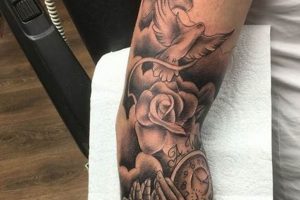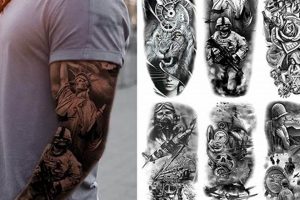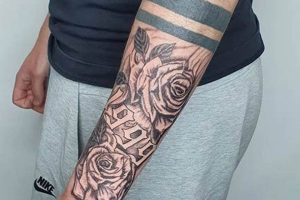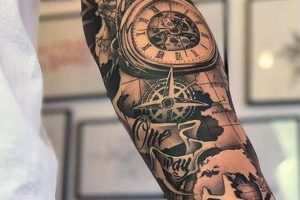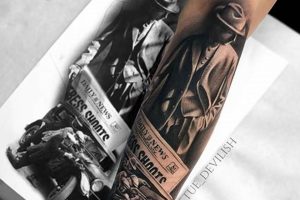A full-arm tattoo, extending from shoulder to wrist, featuring a skull as the central motif, offers a large canvas for artistic expression. This style allows for incorporation of various elements, such as flowers, animals, geometric patterns, and other imagery, woven around the skull to create a cohesive and personalized design. Examples include a skull intertwined with roses, representing life and death, or a skull combined with a clock, symbolizing the passage of time.
Full-arm skull tattoos provide a powerful medium for self-expression, allowing individuals to communicate complex themes like mortality, remembrance, or overcoming adversity. The enduring popularity of this imagery stems from its rich symbolism across cultures and its adaptability to diverse artistic styles, from traditional to realistic to abstract. Historically, skulls have represented both death and the celebration of life, providing a potent visual statement that continues to resonate today. This enduring appeal contributes to the prevalence of these designs in contemporary tattoo art.
Exploring specific styles, design considerations, and the collaborative process between artist and client further clarifies the potential of these impactful body art pieces. Understanding the symbolic meaning behind different elements incorporated within the design allows for a deeper appreciation of their significance.
Tips for Designing a Skull Sleeve Tattoo
Careful planning ensures a cohesive and impactful full-arm skull tattoo. Consider these essential tips before committing to a design.
Tip 1: Research Artists: Seek artists specializing in the preferred style (e.g., realism, traditional, neo-traditional). Review portfolios to assess skill and experience with similar subject matter.
Tip 2: Develop a Concept: Clearly define the desired theme and symbolism. Consider elements beyond the skull, such as accompanying imagery, color palettes, and overall aesthetic.
Tip 3: Collaboration is Key: Open communication with the chosen artist is crucial. Discuss ideas, provide references, and be receptive to their expertise and suggestions.
Tip 4: Consider Placement and Flow: The curvature of the arm influences the design’s visual impact. Work with the artist to ensure elements flow naturally and complement the body’s contours.
Tip 5: Think Long-Term: Large-scale tattoos require multiple sessions and represent a significant commitment. Ensure the chosen design resonates deeply and aligns with long-term aesthetic preferences.
Tip 6: Pain Management: Prepare for multiple sessions and varying levels of discomfort. Discuss pain management techniques with the artist and take appropriate aftercare measures.
Tip 7: Budget Appropriately: Large, intricate designs require significant investment. Discuss pricing upfront and plan accordingly to avoid financial strain during the process.
Thorough preparation, artist selection, and clear communication contribute significantly to a successful and fulfilling tattoo experience. These factors ensure the final result aligns with personal vision and artistic expectations.
By adhering to these guidelines, one can achieve a visually striking and personally meaningful full-arm tattoo that stands the test of time.
1. Placement
Strategic placement significantly impacts the visual narrative of a skull sleeve tattoo. Consideration of the arm’s natural contours and musculature influences how the design flows and interacts with the body’s movement. Placement choices contribute to the overall composition, emphasizing specific elements and creating a dynamic or static feel.
- Shoulder Emphasis:
Positioning the skull prominently on the shoulder creates a powerful focal point. This placement allows for larger designs and can incorporate elements that extend onto the chest or back. The shoulder’s rounded shape lends itself well to showcasing the skull’s three-dimensional form, enhancing its visual impact.
- Forearm Focus:
Placing the skull on the forearm offers greater visibility and allows for interaction with other existing tattoos. This location suits designs that incorporate elements flowing towards the wrist or hand, creating a sense of movement and continuation.
- Elbow Incorporation:
The elbow presents a unique anatomical challenge and opportunity. Skilled artists can utilize the joint’s natural bend to create dynamic designs that appear to flex and shift with the arm’s movement. This placement requires careful planning to avoid distortion and ensure visual coherence.
- Overall Composition:
Regardless of the skull’s primary location, the entire arm serves as a canvas. Supporting elements, such as flowers, flames, or geometric patterns, should be strategically positioned to complement the skull and create a cohesive narrative. The flow of these elements contributes significantly to the sleeve’s overall aesthetic impact.
Thoughtful placement decisions elevate a skull sleeve from a collection of individual elements to a unified and dynamic work of art. Harmonizing the design with the body’s natural form enhances its visual impact and ensures a cohesive and aesthetically pleasing result.
2. Style (realism, traditional)
Artistic style significantly influences the aesthetic and symbolic impact of skull sleeve tattoos. Choosing a specific style dictates the overall tone, level of detail, and visual interpretation of the central motif and accompanying elements. Understanding the nuances of various styles allows for informed decisions that align with individual preferences and desired outcomes.
- Realism:
Realistic depictions of skulls emphasize anatomical accuracy and intricate detail. This style often incorporates shading and highlighting techniques to create a three-dimensional effect, mimicking the textures and contours of bone. Realistic skull tattoos can evoke a sense of macabre beauty or serve as powerful reminders of mortality.
- Traditional:
Traditional skull tattoos, rooted in classic Americana and sailor tattooing, feature bold lines, solid colors, and simplified forms. This style often incorporates iconic imagery like roses, anchors, and daggers, adding layers of symbolic meaning. Traditional skull tattoos convey a sense of timelessness and classic appeal.
- Neo-Traditional:
Neo-traditional builds upon the foundations of traditional tattooing, incorporating bolder color palettes, more intricate details, and stylized imagery. This style allows for greater creative freedom while retaining the core elements of traditional aesthetics. Neo-traditional skull tattoos offer a vibrant and contemporary take on a classic theme.
- Illustrative:
Illustrative skull tattoos draw inspiration from various art forms, including comic books, graphic novels, and fine art. This style often features bold outlines, dynamic compositions, and stylized interpretations of the skull motif. Illustrative tattoos can range from whimsical and cartoonish to dark and surreal.
The chosen style significantly impacts the overall impression conveyed by a skull sleeve tattoo. Careful consideration of stylistic elements, in conjunction with personal preferences and desired symbolism, ensures a cohesive and impactful final result. Selecting an artist specializing in the preferred style further enhances the realization of the intended vision.
3. Supporting Elements
Supporting elements play a crucial role in enriching the narrative and visual depth of skull sleeve tattoos. These elements, carefully chosen and integrated, transform a standalone skull motif into a complex and personalized statement. They contribute layers of symbolism, enhance visual interest, and create a cohesive design that extends beyond a single image. The selection and placement of supporting elements significantly influence the overall impact and meaning of the tattoo.
Several factors contribute to the effective incorporation of supporting elements. Consideration of thematic coherence ensures that accompanying imagery aligns with the intended message. For instance, roses symbolize love and loss, while clocks represent the passage of time and the inevitability of mortality. These symbolic pairings enhance the skull’s inherent association with death and remembrance. Visual balance and composition are also crucial; elements should be strategically positioned to complement the skull and create a harmonious flow across the arm. Overcrowding can detract from the overall impact, while strategic negative space can enhance visual clarity and emphasize key elements. The interplay of these factors contributes to a cohesive and impactful design.
Practical application of these principles involves careful planning and collaboration with a skilled tattoo artist. Open communication regarding desired themes, symbolic preferences, and stylistic choices ensures that the final design accurately reflects individual vision. Examples of successful integration include a skull entwined with serpents, symbolizing transformation and rebirth, or a skull adorned with feathers, representing freedom and transcendence. Understanding the interplay between supporting elements and the central skull motif allows for the creation of deeply personal and visually compelling body art. This collaborative approach ensures that the final result resonates with individual meaning and stands as a powerful expression of personal narrative.
4. Color palette
Color palettes significantly influence the mood, visual impact, and overall interpretation of skull sleeve tattoos. Color choices can amplify or soften the inherent symbolism of the skull, ranging from stark black and grey realism to vibrant and illustrative interpretations. Careful consideration of color theory and its emotional impact ensures a cohesive design that effectively communicates the intended message.
Monochromatic palettes, utilizing shades of black and grey, often evoke a sense of gravity and realism. This approach emphasizes the skull’s form and texture, lending itself well to detailed depictions of bone structure. The absence of color allows for a focus on the interplay of light and shadow, creating a dramatic and sometimes somber effect. Conversely, vibrant color palettes can imbue skull tattoos with a sense of energy and vitality. Bold colors, such as reds, oranges, and yellows, can create a striking contrast against the darker tones typically associated with skulls, symbolizing themes of passion, defiance, or celebration of life. Similarly, cooler colors, such as blues, greens, and purples, can evoke a sense of mystery, spirituality, or the ethereal. The interplay of warm and cool colors within a single design can create visual depth and complexity, adding layers of symbolic meaning.
Effective color palette selection involves understanding the inherent symbolism of individual colors and their combined effect. Red, often associated with passion and danger, can amplify the skull’s macabre connotations or represent vital energy. Blue, often associated with tranquility and spirituality, can imbue the skull with a sense of peace or evoke themes of the afterlife. Green, often associated with growth and renewal, can represent the cyclical nature of life and death. The interplay of these symbolic associations allows for nuanced and personalized interpretations of the skull motif. Ultimately, the chosen color palette should harmonize with the overall design and effectively communicate the intended message, enhancing the visual impact and symbolic depth of the skull sleeve tattoo.
5. Customization
Customization stands as a cornerstone of impactful skull sleeve tattoo designs. It transforms a common motif into a deeply personal statement, reflecting individual narratives, beliefs, and aesthetic preferences. Customization imbues the tattoo with unique significance, moving beyond generic representation to a powerful expression of self. This process elevates the skull sleeve from a mere image to a wearable piece of art that resonates with individual meaning.
The ability to personalize skull sleeve tattoos opens avenues for incorporating elements of personal history, passions, and symbolic representations. Incorporating specific flowers, objects, or patterns allows individuals to weave their stories into the design. A musician might incorporate musical notes or instruments alongside the skull, while a nature enthusiast might choose foliage and animals. These personalized elements transform the tattoo into a visual autobiography, narrating individual experiences and values. Furthermore, customization extends to stylistic choices, allowing individuals to select a style that aligns with their aesthetic sensibilities, ranging from photorealism to traditional to abstract. This fusion of personal narrative and artistic style creates a truly unique and meaningful piece of body art. Examples include incorporating a loved one’s name into the design, integrating elements reflecting cultural heritage, or choosing imagery representing a significant life event. These personalized touches transform the tattoo into a powerful reminder of personal connections and experiences. The skull itself can also be customized: its expression, the presence or absence of a jawbone, and the inclusion of cracks or other embellishments all contribute to the overall narrative.
Ultimately, customization empowers individuals to reclaim and reinterpret the symbolic weight of the skull. It allows the wearer to move beyond conventional interpretations of mortality and embrace meanings of resilience, remembrance, or personal transformation. The process fosters a deeper connection between the individual and the tattoo, ensuring its lasting relevance and personal significance. This customization not only enriches the visual design but also imbues it with a profound sense of personal ownership and meaning, making it a true reflection of the individual’s unique journey and identity.
Frequently Asked Questions
Addressing common inquiries regarding full-arm skull tattoos provides clarity and facilitates informed decision-making. Openly discussing these concerns with a qualified tattoo artist ensures realistic expectations and a positive tattooing experience.
Question 1: How much does a full-arm skull tattoo typically cost?
Pricing depends on factors such as artist experience, design complexity, and geographic location. Large-scale projects require significant time investment, often spanning multiple sessions. Obtaining a detailed quote from a chosen artist after discussing the desired design is recommended.
Question 2: How long does a full-arm skull tattoo take to complete?
Completion time varies based on design intricacy and individual pain tolerance. Multiple sessions, spaced weeks apart for healing, are typical. Complex designs can require several months or even a year to complete fully.
Question 3: What are the most important factors to consider when choosing a tattoo artist?
Experience, portfolio quality, specialization in the desired style, and hygiene practices are crucial. Researching artists, reviewing their previous work, and scheduling consultations helps ensure compatibility and confidence in their abilities.
Question 4: What are the best aftercare practices for a full-arm skull tattoo?
Following artist instructions regarding cleaning, moisturizing, and sun protection is essential. Proper aftercare promotes healing, prevents infection, and preserves the vibrancy of the tattoo over time. Consulting with the artist about specific aftercare products and practices is recommended.
Question 5: Can a full-arm skull tattoo be covered up or removed?
Cover-ups and removals are possible, but present significant challenges due to the tattoo’s size and complexity. Laser removal can be costly and time-consuming, while cover-ups require careful planning and execution by a skilled artist. Thorough consideration of design choices before starting a full-arm tattoo is advisable.
Question 6: Does the location on the arm affect the pain level during tattooing?
Areas with thinner skin or closer proximity to bone, such as the inner arm and elbow, tend to be more sensitive. Individual pain tolerance also varies. Discussing pain management techniques with the artist can help alleviate discomfort during the process.
Thorough research, open communication with a chosen artist, and realistic expectations contribute significantly to a positive and successful tattooing experience. Addressing these common concerns beforehand ensures informed decisions and minimizes potential complications.
Further exploration of specific design elements and stylistic choices enhances understanding and facilitates the creation of a truly personalized and impactful full-arm skull tattoo.
Conclusion
Full-arm skull tattoos offer a powerful canvas for artistic expression and personal narrative. Careful consideration of placement, style, supporting elements, color palettes, and customization options allows for the creation of deeply meaningful and visually striking designs. Understanding the historical and symbolic weight of the skull, coupled with thorough planning and collaboration with a skilled artist, ensures a successful and fulfilling tattooing experience. Addressing practical concerns, such as cost, time commitment, and aftercare, further contributes to a positive outcome.
Ultimately, a well-executed full-arm skull tattoo transcends mere aesthetics, becoming a powerful statement of personal identity and a testament to the enduring power of body art. The commitment involved underscores the importance of thoughtful design choices and the transformative potential of this impactful art form.



